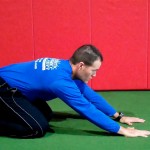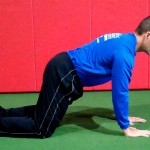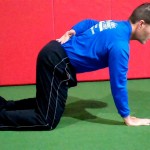Brian Schiff’s Blog
Injury Prevention, Sports Rehab & Performance Training Expert
I utilize bridging as an assessment and exercise tool in my training and rehab programs. Posterior chain/hip stability is poor in many clients. The ability to maintain a neutral spine, engage the glutes and fight rotation is NOT an easy task by any means. So, coaching and cueing proper bridging is a great way to enhance pillar strength and reduce injury risk, while facilitating better movement patterns in sport.
I wrote a recent column for PFP magazine entitled iso bridge with alternate knee extension. Click here to read the column and the application, regression and progression of the exercise. In addition, I have included a short video below showing double leg and single leg bridge exercises that can be used to work on the hips and core. The second exercise is the dynamic version of the iso alternate knee extension bridge I write about. I show you some of the single leg progressions that come after mastering the iso bridge as well.
I hope this video and article is useful to you. I also want to take this opportunity to thank you for reading my blog and wish you a very Happy New Year!
Below are two videos demonstrating some sliding exercises I like to use in training and rehab. The first video reveals one of my tougher hamstring exercises I prescribe, while the second video displays some shoulder/core stability variations using sliding discs. I have included links to the PFP columns that better explain the set-up, execution and application for each exercise.
Click here for the Functionally Fit Column on sliding hamstring curls.
Click here for the Functionally Fit column on sliding shoulder raises.
I work with lots of patients and clients who consistently demonstrate inadequate hip and core stability. I see this show up routinely as asymmetrical 1’s for the trunk stability push-up, in-line lunge, hurdle step and rotary stability movements on the FMS. Unfortunately, this has been a recurring them in many of my females recovering from ACL reconstruction as well as runners with persistent pain/dysfunction in one lower extremity.
I am always looking for better ways to train the body in whole movement patterns as well as functional positions. One of my preferred positions is to test and challenge my clients in a split squat position. I begin with an isometric split squat cueing proper alignment and muscle activation. As clients master isometric postural control, I will allow them to add an isotonic movement by squatting in the position.
As they progress, I will add in perturbations to stimulate changes or challenges to their center of gravity. Often, you will see them struggle much more on the involved side. But to be honest, I find most people have an incredibly hard time maintaining proper alignment for long without cheating or falling forward or to the side. Allowing clients to lose form is okay provided they are cued to fix their alignment or they naturally self correct.
An additional wrinkle I throw in for this training is using the BOSU Balance Trainer. Below is a video that shows how I use this progressing from shin down to just the toes as a support on the trail leg. The second version will burn up your clients’ thighs and quickly become one of their least favorite exercises. The great thing is that you do not have to offer much resistance to create a significant perturbation.
For more detail on this exercise and application, click here to read my PFP column featuring it this week.
Research along with years of observation has taught me that the brain is inherently looking for the most efficient way (aka least effort) to execute movement in life. In addition, it HATES pain just like you and I so it does everything possible to avoid it including ordering the body to perform dysfunctional movement patterns.
After a painful episode, the brain often needs reminded that the body can go back to the proper movement patterns once the pain is gone. However, it often holds that painful memory and may by default lean toward a faulty movement pattern. This protective mode then ends up perpetuating a faulty movement pattern that is no longer necessary nor efficient. Over time, dysfunctional movement patterns can create further stress or harm to other segments in the kinetic chain.
So, I am always seeking ways to stimulate the body to work properly and exercises that facilitate proper neuromuscular patterning are instrumental in my rehab and training. I wanted to share two exercises that I like to utilize in my rehab and training for the shoulder. In particular, I like to employ closed chain activity to stimulate the serratus anterior as well as the other scapular stabilizers.
Below are two exercises I wrote about in my “Functionally Fit” column for PFP magazine. The first exercise shows quadruped rocking. Shirley Sahrmann mentions this in her work, Diagnosis and Treatment of Movement Impairment Syndromes. I began using it after reading her book, and I agree that it works very well for scapular dysfunction. Below is the start and finish position for the quadruped version as well as my own advanced tripod version of the exercise.
- Quadruped start
- Quadruped finish
- Tripod finish
For a complete explanation of the exercise and its application, click here to read the column.
As a follow-up to this exercise, I included an unstable progression I like to employ using the BOSU trainer. I call this the unstable tripod scapular clock. It can be done on the knees or up on the toes. I have included a quick video on this below. Again, I like this exercise for scapular work as well as core stability training.
Click here to read my PFP column on this exercise for the full description, application and regressions. The real beauty of this last exercise is the “big bang for your buck” attributes since it hits shoulder, core and hip stability all at once for those able to work at that level. I hope it works as well for you as it has for me!
Through my clinical practice and sports performance training, I continue to focus on eliminating core and hip dysfunction. I think many of the knee problems I see in runners and females are related to weakness in the glutes and small lateral rotators. There has also been quite a buzz about a recent article written in the Strength & Conditioning Journal on crunches and whether spinal flexion may actually be good for you.
This topic alone could take up several posts so, I will not delve into that today. However, as one who has experienced sciatica and disc injury firsthand, I probably tend to fall a little more in the camp of focusing on a neutral spine and resisting external forces as I feel this helps improve performance and reduce injury risk. In that vain, I have been continuing to develop my own core and hip stability progressions with my advanced clients/athletes.
I have been doing a series of posts for BOSU and PFP in my Functionally Fit Column. In my last post, I covered a 3D mountian climber with hip extension. In today’s post, I am covering a great core exercise with the BOSU Ballast Ball focusing on hip extension with the goal of improving shoulder, core and hip stability while promoting hip extension and disassociation.
In the video below you can check out the progressions (incline and decline)
Click here to read the full article on technique and application. The article reviews a regression for those not ready to tackle this quite yet. I think you will find this exercise challenging and rewarding.




